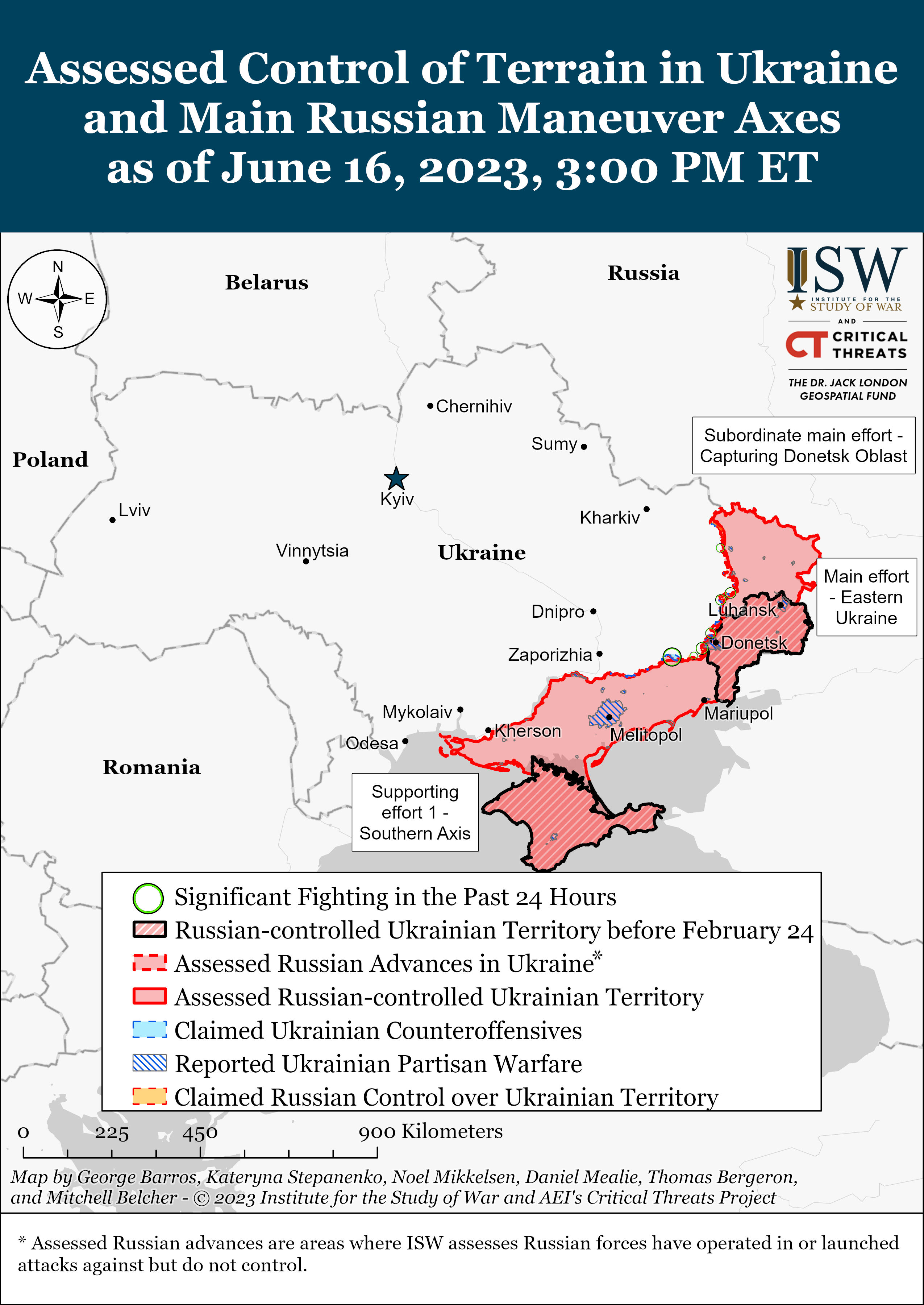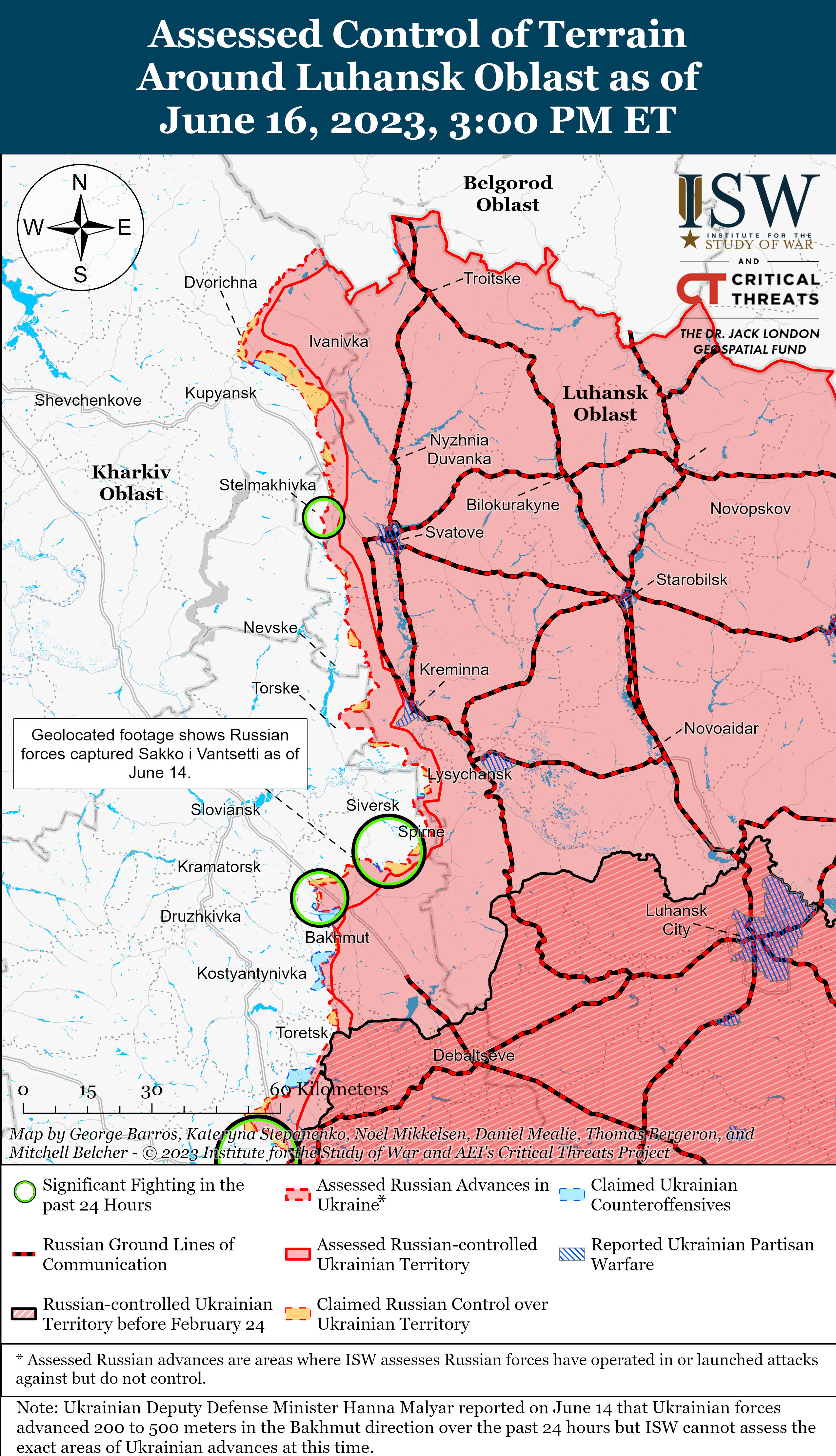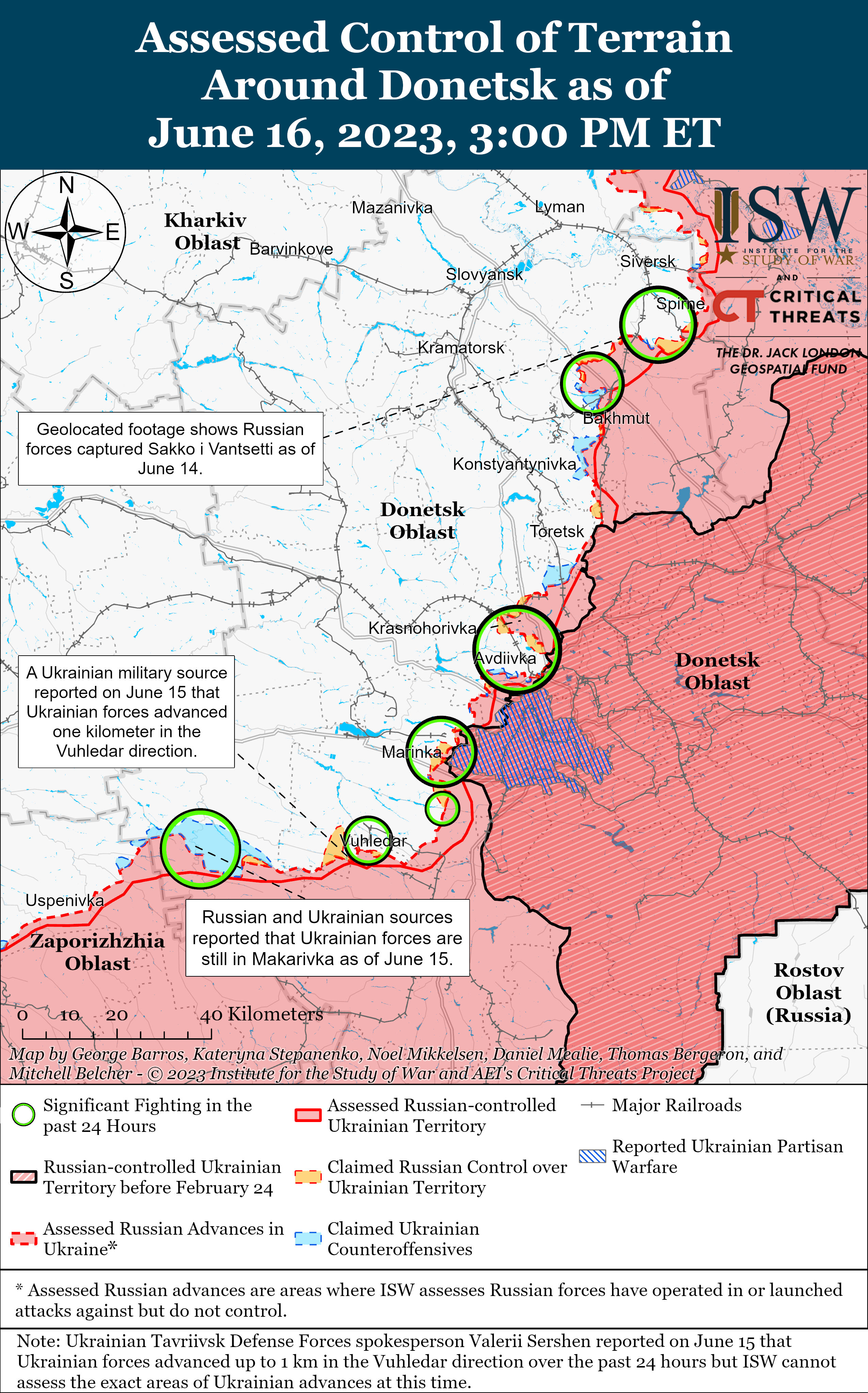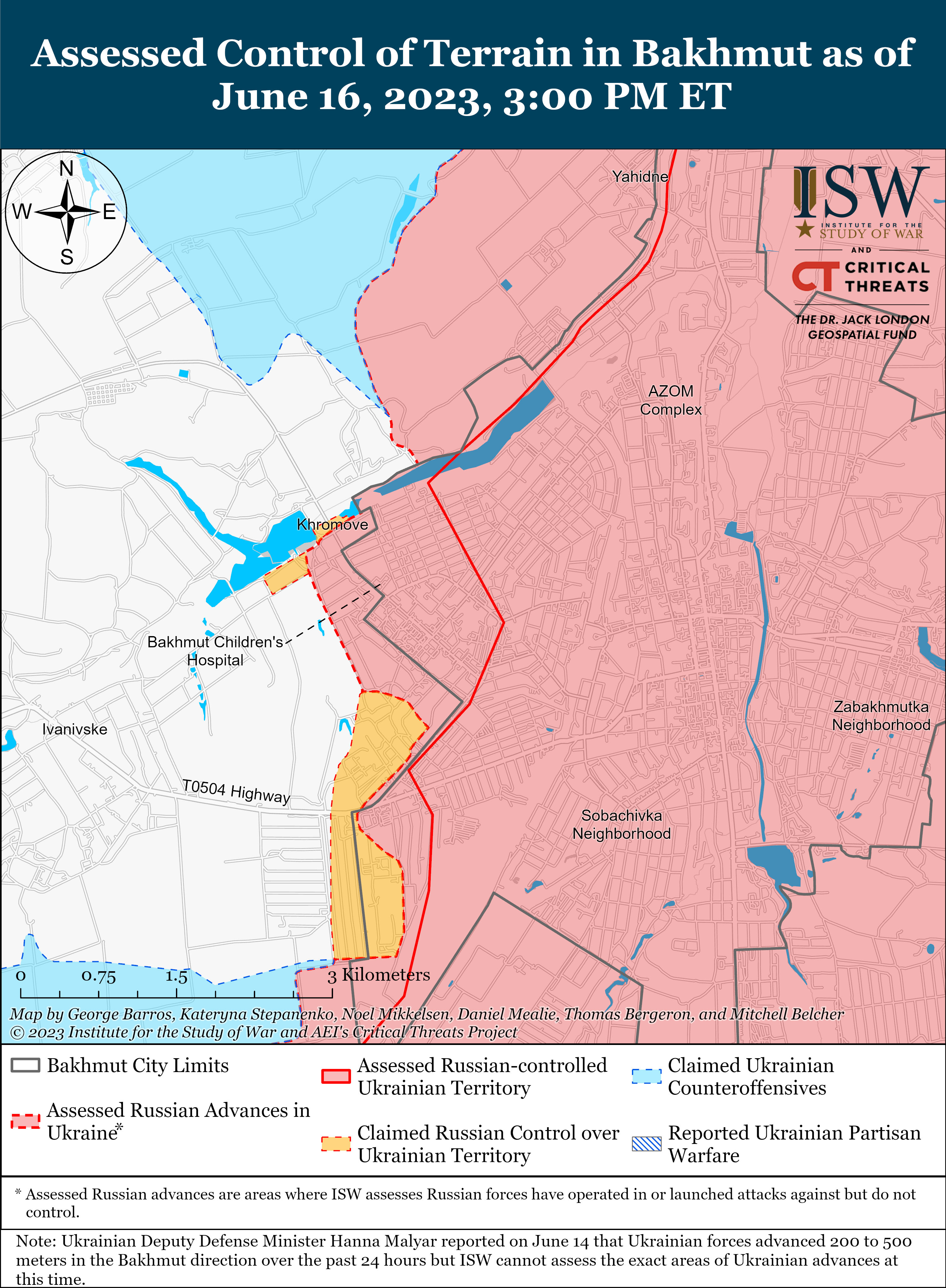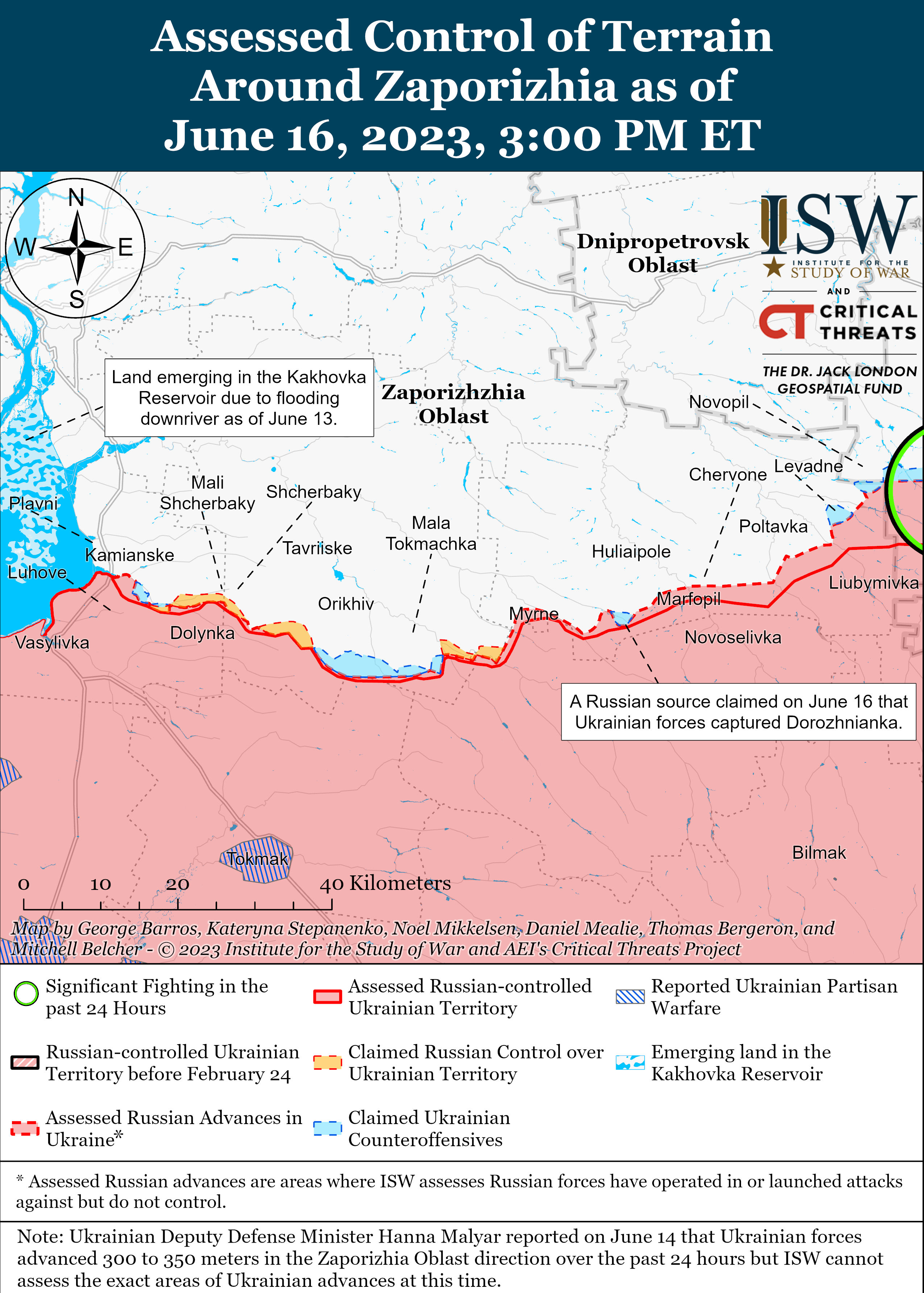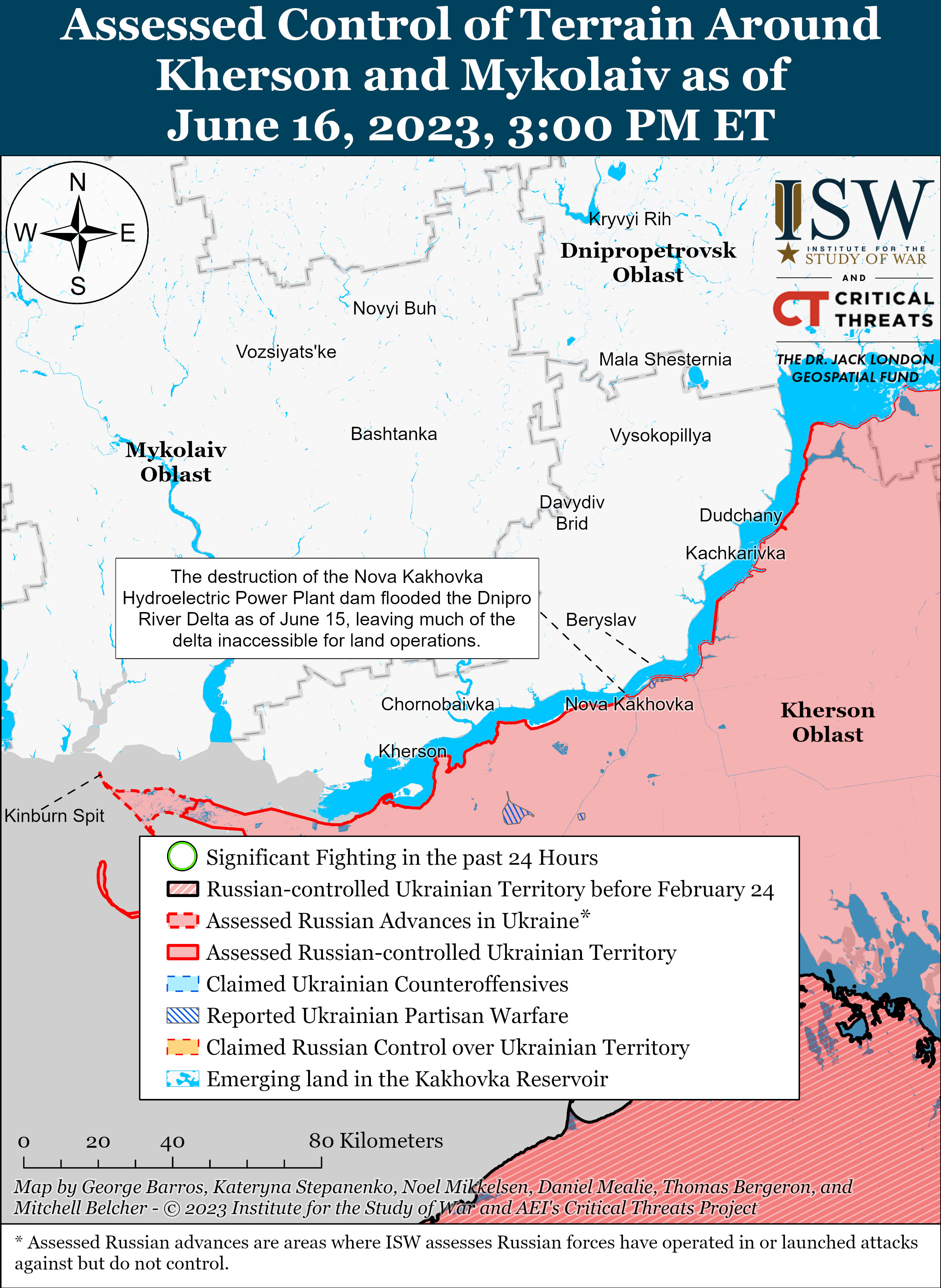Russian Offensive Campaign Assessment, June 16, 2023
AFGHANISTAN, June 16 - Russian Offensive Campaign Assessment, June 16, 2023
Riley Bailey, Nicole Wolkov, Grace Mappes, Karolina Hird, and Mason Clark
June 16, 2023, 5:15pm ET
Click here to see ISW’s interactive map of the Russian invasion of Ukraine. This map is updated daily alongside the static maps present in this report.
Click here to access ISW’s archive of interactive time-lapse maps of the Russian invasion of Ukraine. These maps complement the static control-of-terrain map that ISW produces daily by showing a dynamic frontline. ISW will update this time-lapse map archive monthly.
Note: The data cutoff for this product was 2pm ET on June 16. ISW will cover subsequent reports in the June 17 Russian Offensive Campaign Assessment.
Ukrainian forces continued counteroffensive actions on at least three sectors of the front on June 16 and reportedly made gains. The Ukrainian General Staff stated that the Ukrainian forces conducted successful counteroffensive operations southwest of Bakhmut near Stupochky (about 12km southwest of Bakhmut); in western Donetsk Oblast near Vuhledar; in the western Donetsk-eastern Zaporizhia Oblast border area along the Levadne-Staromaiorske line; and in western Zaporizhia Oblast along the Novodanlylivka-Robotyne line.[1] Geolocated footage posted on June 15 indicates that Ukrainian forces have made marginal gains on the northwestern outskirts of Bakhmut west of Yahidne, and Russian milbloggers claimed that Ukrainian troops continued counterattacks northwest, west, and southwest of Bakhmut.[2] Russian milbloggers additionally claimed that Ukrainian forces continued attacking Russian positions south of Velyka Novosilka in western Donetsk Oblast, made gains in central Zaporizhia Oblast just south of Hulyaipole, and mounted offensive operations southwest of Orikhiv.[3]
Russian forces targeted Kyiv and Kryvyi Rih with cruise missiles and kamikaze drones on June 15-16. The Ukrainian General Staff reported that Russian forces conducted five missile strikes with Kh-59, Kh-101, and Kh-555 cruise missiles on June 15 and that Ukrainian forces also shot down two Shahed drones.[4] Dnipropetrovsk Oblast Head Serhiy Lysak reported that Russian missiles had targeted two industrial facilities in Kryvyi Rih on June 15.[5] Ukrainian officials also reported that Ukrainian air defenses intercepted six Russian Kinzhal and six Kaliber missiles that targeted Kyiv Oblast during the day on June 16, coinciding with the visit of several African heads of state in Kyiv.[6]
The heads of state of seven African countries met with Ukrainian President Volodymyr Zelensky on June 16 in Kyiv as part of joint peace mission. President of South Africa Cyril Ramaphosa, President of Zambia Hakainde Hichilema, President of Comoros Azali Assoumani, President of the Republic of the Congo Denis Sassou Nguesso, Prime Minister of Egypt Mostafa Mabdouly, President of Senegal Macky Sall, and a Ugandan representative met with the Ukrainian leadership in Kyiv.[7] Russian forces conducted a missile strike on Kyiv during the visit, forcing the African leaders to take shelter in bunkers during their meetings.[8] Some Russian milbloggers claimed that Russian forces did not conduct missile strikes on Kyiv during the African leaders’ visit, while another absurdly claimed that it was the Ukrainian forces that staged the attack.[9] The African leaders will continue their trip onward to St. Petersburg on June 17 to meet with Russian President Vladimir Putin.[10] ISW will assess this trip in total following readouts from the delegation’s visit to Russia.
The Kremlin claimed Russia has begun transferring tactical nuclear warheads (under Russian control) to Belarus, in line with previously announced plans. Russian President Vladimir Putin announced on June 16 that Russia has moved the first deployment of tactical nuclear warheads to Belarus.[11] Putin stated that Russian forces will deploy the entirety of planned tactical nuclear warheads shipments to Belarus by the end of 2023.[12] ISW previously assessed that the deployment of Russian tactical nuclear weapons to Belarus is part of a longstanding effort to cement Russia’s de facto military control over Belarus and is highly unlikely to presage any Russian escalation.[13]
Select current and former Russian municipal officials signed an open letter calling on the Russian forces to return to the “universally” recognized Russian borders due to the crisis caused by the destruction of the Kakhovka Hydroelectric Power Plant (KHPP) dam. Municipal officials from Moscow and St. Petersburg as well as Moscow and Leningrad oblasts signed the document, which argued that the destruction of the KHPP dam will affect the ecosystem of the planet, health issues, and the economy for many decades.[14] The letter stated that Putin’s actions since February 24, 2022 have caused unspecified catastrophic events but did not cite continued Russian military operations in Ukraine as a reason for the withdrawal of Russian forces.[15] Non-Kremlin aligned Russian officials may be using public concern about the environmental and humanitarian situation associated with the destruction of the KHPP dam to voice opposition to the war in Ukraine without directly criticizing the war effort itself. The Kremlin has widely set the conditions for crackdowns against anti-war dissent. Russians who hold anti-war sentiments may use the destruction of the KHPP to voice their opposition to the war in a very limited fashion.[16]
Key Takeaways
- Ukrainian forces continued counteroffensive actions on at least three sectors of the front on June 16 and reportedly made gains.
- Russian forces targeted Kyiv and Kryvyi Rih with cruise missiles and kamikaze drones on June 15-16.
- The heads of state of seven African countries met with Ukrainian President Volodymyr Zelensky on June 16 in Kyiv as part of a joint peace mission.
- The Kremlin claimed Russia has begun transferring tactical nuclear warheads (under Russian control) to Belarus, in line with previously announced plans.
- Select current and former Russian municipal officials signed an open letter calling on Russian forces to return to “universally” recognized Russian borders due to the crisis caused by the destruction of the Kakhovka Hydroelectric Power Plant (KHPP) dam.
- Russian forces conducted limited ground attacks along the Svatove-Kreminna line.
- Russian and Ukrainian forces conducted ground attacks near Bakhmut and along the Avdiivka-Donetsk City line.
- Ukrainian forces continued ground attacks in the Vuhledar area.
- Ukrainian forces continued counteroffensive operations near the administrative border of Donetsk and Zaporizhia oblasts and reportedly made gains in this area.
- The Russian Ministry of Defense (MoD) is attempting to monetarily incentivize the destruction of Ukrainian military equipment, likely to bolster ongoing recruitment efforts.
- Russian and occupation authorities are attempting to strengthen Russian ground lines of communication (GLOCs) between Russia and occupied Ukraine.
We do not report in detail on Russian war crimes because these activities are well-covered in Western media and do not directly affect the military operations we are assessing and forecasting. We will continue to evaluate and report on the effects of these criminal activities on the Ukrainian military and the Ukrainian population and specifically on combat in Ukrainian urban areas. We utterly condemn these Russian violations of the laws of armed conflict, Geneva Conventions, and humanity even though we do not describe them in these reports.
- Russian Main Effort – Eastern Ukraine (comprised of two subordinate main efforts)
- Russian Subordinate Main Effort #1 – Capture the remainder of Luhansk Oblast and push westward into eastern Kharkiv Oblast and encircle northern Donetsk Oblast
- Russian Subordinate Main Effort #2 – Capture the entirety of Donetsk Oblast
- Russian Supporting Effort – Southern Axis
- Russian Mobilization and Force Generation Efforts
- Activities in Russian-occupied areas
Russian Main Effort – Eastern Ukraine
Russian Subordinate Main Effort #1 – Luhansk Oblast (Russian objective: Capture the remainder of Luhansk Oblast and push westward into eastern Kharkiv Oblast and northern Donetsk Oblast)
Russian forces conducted limited ground attacks along the Svatove-Kreminna line on June 16. The Ukrainian General Staff reported that Russian forces conducted unsuccessful offensive operations near Stelmakhivka (15km northwest of Svatove), Vyiimka (25km south of Kreminna), and Vesele (30km south of Kreminna).[17] Ukrainian Eastern Group of Forces Spokesperson Colonel Serhiy Cherevaty stated that Ukrainian forces repelled five Russian attacks in unspecified areas of Luhansk Oblast.[18] Footage published June 16 purportedly shows the 88th Brigade (2nd Luhansk People’s Republic Army Corps) operating in the Siversk direction south of Kreminna.[19]
Russian Subordinate Main Effort #2 – Donetsk Oblast (Russian Objective: Capture the entirety of Donetsk Oblast, the claimed territory of Russia’s proxies in Donbas)
Click here to read ISW’s retrospective analysis on the Battle for Bakhmut.
Russian and Ukrainian forces conducted limited ground attacks around Bakhmut on June 16. Geolocated footage published on June 16 shows that Russian forces made a limited advance near Kurdyumivka (14km southwest of Bakhmut).[20] The Ukrainian General Staff reported that Russian forces conducted unsuccessful offensive operations near Rozdolivka (19km northeast of Bakhmut), Orikhovo-Vasylivka (11km northwest of Bakhmut), and Stupochky (13km southwest of Bakhmut).[21] A Russian milblogger claimed that Russian forces attacks near Berkhivka (3km northwest of Bakhmut) and Yahidne (1km northwest Bakhmut).[22] Footage published on June 16 purportedly shows the 132nd Separate Motorized Rifle Brigade (1st Donetsk People’s Republic Army Corps) operating near Niu York (30km southwest of Bakhmut).[23] Ukrainian Ground Forces Commander Colonel General Oleksandr Syrskyi stated that Russian forces are moving some of their most combat-ready units to the Bakhmut direction.[24] Syrskyi also stated that Ukrainian forces are occupying positions in dominant heights and forest areas and are pushing Russian forces out of positions in the Bakhmut area.[25] Geolocated footage published on June 16 indicates a limited Ukrainian advance west of Yahidne.[26] A milblogger claimed that Ukrainian forces are advancing on Bakhmut’s flanks and conducted attacks near Klishchiivka (7km southwest of Bakhmut), Kurdyumivka (12km southwest of Bakhmut), and Ozaryanivka (14km southwest of Bakhmut).[27]
Russian and Ukrainian forces conducted ground attacks along the Avdiivka-Donetsk City line. Geolocated footage published on June 16 indicates that Russian forces made limited gains near Novoselivka (17km northeast of Avdiivka).[28] The Ukrainian General Staff reported that Russian forces conducted unsuccessful offensive operations near Avdiivka, Stepove (7km northwest of Avdiivka), Marinka (on the southwestern outskirts of Donetsk City), Krasnohorivka (5km north of Marinka), and Novomykhailivka (10km south of Marinka).[29] Russian milbloggers claimed that Russian forces advanced in Marinka and that elements of the 20th Motorized Rifle Division (8th Combined Arms. Army, Southern Military District) occupied new positions north of Novomykhailivka.[30] Chechen Republic Head Ramzan Kadyrov claimed that Chechen “Akhmat” Special Forces (Spetsnaz) control most of Marinka.[31] The Russian Ministry of Defense (MoD) claimed that Russian forces repelled five Ukrainian attacks near Stepove, Pervomaiske (11km southwest of Avdiivka), and Staromykhailivka (19km southwest of Avdiivka).[32] A milblogger claimed that Ukrainian forces made limited advances near Nevelske (14km southwest of Avdiivka).[33]
Russian Supporting Effort – Southern Axis (Russian objective: Maintain frontline positions and secure rear areas against Ukrainian strikes)
Ukrainian forces continued ground attacks in the Vuhledar area on June 16. The Ukrainian General Staff reported that Ukrainian forces achieved unspecified success in some areas near Vuhledar (30km southwest of Donetsk City) and fixed themselves in new positions.[34] The Ukrainian Tavriisk Group of Forces Press Center previously reported on June 15 that Ukrainian forces advanced up to 1km near Vuhledar.[35] A Russian milblogger claimed that Ukrainian forces conducted assaults south of Vuhledar on June 16.[36] The Ukrainian General Staff reported that Russian forces conducted a counterattack in the direction of Vodyane (6km northeast of Vuhledar).[37] The Russian Eastern Grouping of Forces Spokesperson Oleg Chekhov reported that Russian forces repelled Ukrainian reconnaissance-in-force operations near Vodyane.[38]
Ukrainian forces continued counteroffensive operations near the administrative border of Donetsk and Zaporizhia oblasts and reportedly made gains in this area on June 16. The Ukrainian General Staff reported that Ukrainian forces conducted successful offensive operations along the Levadne-Staromaiorske line (20km southwest to 10km south of Velyka Novosilka).[39] The Russian MoD and Russian sources claimed that Russian forces repelled assaults southwest, south, and southeast of Velyka Novosilka.[40] A prominent milblogger claimed that Ukrainian forces made marginal gains southeast of Velyka Novosilka and that fighting is ongoing south of Velyka Novosilka.[41] A Russian milblogger amplified footage on June 15 purporting to show elements of the “Kaskad” Operational Tactical Combat Formation repelling Ukrainian assaults south of Velyka Novosilka.[42]
Ukrainian forces continued limited ground attacks in western Zaporizhia Oblast and made gains in this area on June 16. The Ukrainian General Staff reported that Ukrainian forces conducted successful offensive operations in the direction of the Novodanylivka-Robotyne line (6km to 15km south of Orikhiv).[43] A Russian milblogger claimed that Ukrainian forces made unspecified progress near Robotyne and captured new positions near Dorozhnyanka (35km southeast of Orikhiv).[44] Russian milbloggers claimed that Ukrainian forces conducted assaults southwest of Orikhiv and that elements of the 429th Motorized Rifle Regiment (19th Motorized Rifle Division, 58th Combined Arms Army, Southern Military District) repelled the assaults.[45]
Russian sources claimed that Ukrainian sabotage and reconnaissance groups landed on the east (left) bank of Kherson Oblast and established positions there. Russian sources claimed that Ukrainian sabotage and reconnaissance groups landed near Nova Kakhovka (48km east of Kherson City) and unsuccessfully attempted to land near Hola Prystan (13km south of Kherson City) on the evening of June 15.[46] Russian sources amplified footage on June 15 and 16 purporting to show small arms engagements between Ukrainian and Russian forces near Nova Kakhovka and Tavriisk (52km east of Kherson City).[47] Other Russian sources claimed that Ukrainian forces did not conduct river crossings in the area and that Russian forces were firing at Ukrainian drones.[48] A prominent Russian milblogger also claimed that Ukrainian forces landed on islands near Oleshky (9km south of Kherson City) on June 15 and established positions there, although it is not clear what islands given the dynamic topographical situation in the area due to the flooding from the destruction of the Kakhovka Hydroelectric Power Plant (KHPP) dam.[49] ISW has not seen any visual confirmation of Ukrainian forces operating on the left bank of Kherson Oblast since the destruction of the KHPP dam.
Russian forces are reportedly reestablishing defensive positions on the left bank of Kherson Oblast as flood waters continue to recede. Ukrainian Southern Operational Command Spokesperson Natalia Humenyuk reported on June 16 that Russian forces are returning to positions that were previously flooded on the left bank of Kherson Oblast and are intensifying shelling in the area.[50] Ukraine’s Southern Operational Command reported that water levels in the Dnipro, Inhulets, and Southern Bug rivers continue to decrease.[51]
Russian Mobilization and Force Generation Efforts (Russian objective: Expand combat power without conducting general mobilization)
The Russian MoD is attempting to monetarily incentivize the destruction of Ukrainian military equipment, likely to bolster ongoing recruitment efforts and portray Russian forces as capable defenders against Ukrainian attacks. The MoD claimed that it issued payments to over 7,064 Russian military personnel for destroying 4,415 units of Western-made military equipment in Ukraine in 2022. The MoD also claimed that it issued payments of 50,000-300,000 rubles (roughly $598—$3,593) for intercepting Ukrainian drones, rockets, missiles, and destroying various pieces of Soviet and Western-made equipment.[52] The MoD also claimed that Russian forces are destroying Western-provided tanks in the South Donetsk and Zaporizhia directions, but did not mention the claimed payout per unit.
Wagner Group financier Yevgeny Prigozhin is attempting to portray himself as compliant with a recent Russian MoD order formalizing volunteer formations, likely to portray the MoD as the at-fault party in the ongoing Wagner-MoD feud. A Wagner-affiliated channel posted footage of Prigozhin attempting to deliver documents, which Prigozhin claimed were a signed contract with the MoD, to an alleged MoD official.[53] The footage shows the MoD official rebuffing Prigozhin and rejecting the contract. Prigozhin claimed that he would deliver the contract to the Presidential Administration to then give them to Russian Defense Minister Sergey Shoigu, consistent with his ongoing narrative that Wagner is subordinate directly to Russian President Vladimir Putin.[54] Prigozhin claimed that he cannot confirm whether the contract that Wagner received is the same contract that all volunteer formations must sign, and stated that he will not discuss the details of the contract.[55] Prigozhin is likely attempting to contrast himself with Chechen Republic Head Ramzan Kadyrov, who notably celebrated Chechen formations signing the MoD’s subordination contract and is aligning himself as compliant with the MoD.[56]
Russian officials continue efforts to mobilize the Russian defense industrial base (DIB). Russian Security Council Deputy Chairperson Dmitry Medvedev claimed on June 15 that he held a meeting with the Russian Military Industrial Commission at the Aleksin Experimental Mechanical Plant in Tula Oblast on the production of in-demand weapons and military equipment.[57]
Russian federal subjects continue to form and recruit for volunteer formations. Russian opposition outlet Mobilization News reported on June 16 that Belgorod Oblast authorities are actively soliciting employees of Russian cultural institutions to volunteer for the “Cobra-2” volunteer battalion.[58]
Activities in Russian-occupied areas (Russian objective: Consolidate administrative control of annexed areas; forcibly integrate Ukrainian civilians into Russian sociocultural, economic, military, and governance systems)
Russian and occupation authorities are attempting to strengthen Russian ground lines of communication (GLOCs) between Russia and occupied Ukraine. The Russian Government announced on June 16 that it is nationalizing four highways between Russia and occupied Ukraine in order to improve transport routes.[59] The Russian Government stated that it is nationalizing the R-150 Belgorod-Starobilsk-Luhansk City-Donetsk City-Mariupol highway, the R-260 Volgograd- Kamensk-Shakhtinsky-Luhansk City highway, the R-280 Rostov-on-Don-Mariupol-Melitopol-Simferopol highway, and the A-258 Kantermirovka-Luhansk City highway and will repair areas of each. Russian Deputy Prime Minister Marat Khusnullin announced that Russia intends to complete the construction of a 1,400-kilometer highway that will circle around the Sea of Azov in Russian and occupied Ukrainian territories.[60]
Ukrainian partisans reportedly targeted a Russian ground line of communication (GLOC) in occupied Luhansk Oblast. Former Ukrainian Luhansk Oblast Head Serhiy Haidai reported that Ukrainian partisans scattered spikes on an unspecified section of the T1302 Starobilsk-Novopskov highway, damaging the wheels of four Russian vehicles.[61] ISW has not observed Russian corroboration of this report.
Significant activity in Belarus (Russian efforts to increase its military presence in Belarus and further integrate Belarus into Russian-favorable frameworks).
ISW will continue to report daily observed Russian and Belarusian military activity in Belarus, as part of ongoing Kremlin efforts to increase their control over Belarus and other Russian actions in Belarus.
See topline text.
Note: ISW does not receive any classified material from any source, uses only publicly available information, and draws extensively on Russian, Ukrainian, and Western reporting and social media as well as commercially available satellite imagery and other geospatial data as the basis for these reports. References to all sources used are provided in the endnotes of each update.
Legal Disclaimer:
EIN Presswire provides this news content "as is" without warranty of any kind. We do not accept any responsibility or liability for the accuracy, content, images, videos, licenses, completeness, legality, or reliability of the information contained in this article. If you have any complaints or copyright issues related to this article, kindly contact the author above.

